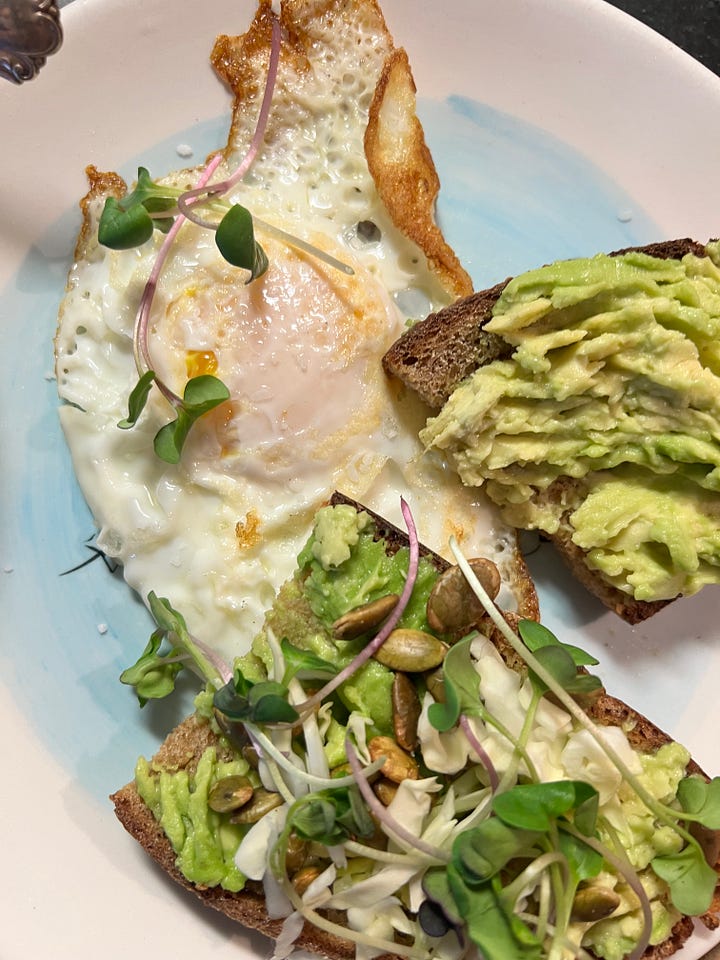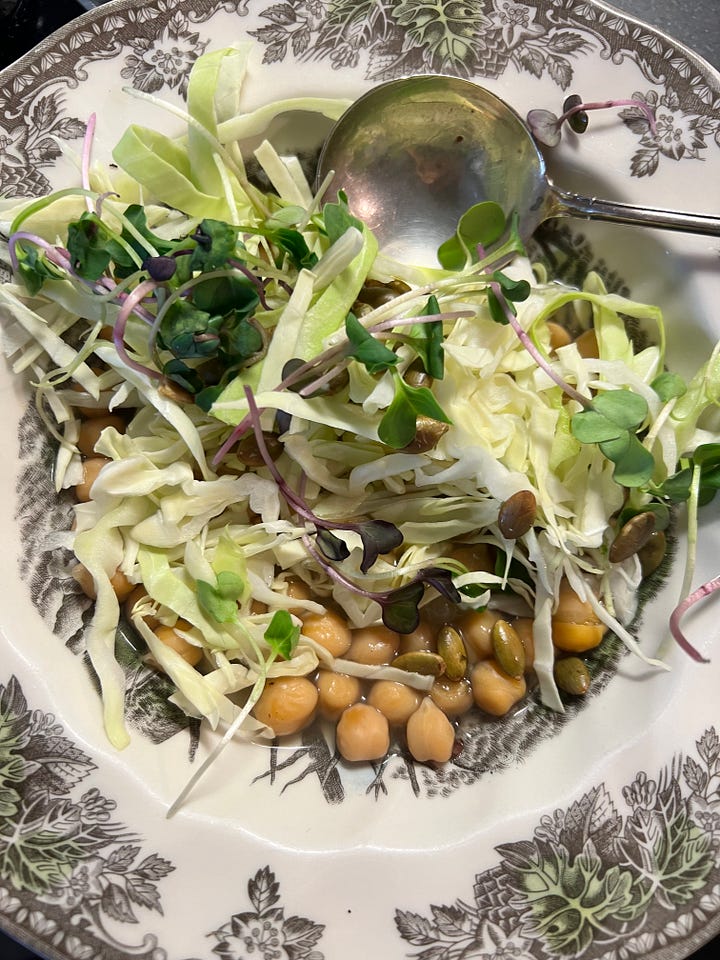I never thought I would be the one to say, “I am not watching the news.”
The fear and stress are real. Whether it is affecting us personally or someone we know. We may feel helpless, hearing about institutions collapsing and people losing their career through an email, or wondering if today is the day the immigration crackdown will affect your state, town or neighbor. Its overwhelming.
For those of us who would like to think we have a handle on everything, news flash, we cannot “talk or reason” ourselves out of fear, it will be on a continuous loop until we get our bodies involved. Today may be the day. What does this look like? A couple of examples could be engaging in physical exercise including going outside in nature, or my favorite, through eating certain foods that help to regulate blood sugar and help to guide our hormones out of our body into the toilet instead of reabsorption into the bloodstream. These acts will put us in a space where we can address our stress.
I recommend you do all of the above and this newsletter today will share one method: how eating beans can assist getting us back to a state of calm. First, lets understand what is happening.
Hormonal Response to Fear & Stress-What Happens in our Bodies?
When we experience fear or stress, our body's endocrine system responds by releasing various hormones that prepare us for fight, flight, or adaptation. Here’s what happens:
Initial Perception
The amygdala, the brain's fear-processing center, detects a threat (real or perceived).
It sends signals to the hypothalamus, (in laymen’s terms, which is all I have, the hypothalmus acts as the command center for hormonal response).
Hormonal Release
Fear Response (Acute): The sympathetic nervous system is activated almost instantly, releasing:
Adrenaline (epinephrine) – Increases heart rate, blood pressure, and energy supply.
Noradrenaline (norepinephrine) – Heightens alertness and reaction time.
Stress Response (Chronic or Prolonged): The HPA (Hypothalamic-Pituitary-Adrenal) axis takes over, triggering:
Cortisol – Mobilizes glucose for energy, suppresses non-essential functions (digestion, immune response), and increases blood sugar.
Hormonal Cycling & Reabsorption
Once the immediate threat is over, the body works to remove excess hormones.
If stress is ongoing, cortisol remains high, leading to chronic inflammation, weight gain, and blood sugar dysregulation.
Excess stress hormones must be removed from the body to maintain balance.
Great - What does that Mean?
It means we have a shit ton of hormones coursing through our body wanting to get the heck out and just when we think they are going out, they get pulled back into the bloodstream-over and over again. This, in turn, affects our inflammation levels and can wreak havoc over time. We can do better. Enter the beautiful bean.
How Beans (Soluble Fiber) Help Remove Excess Hormones
Once stress hormones have served their purpose, the body must eliminate them. This is where soluble fiber from beans plays a crucial role:
Hormones Are Processed by the Liver
Cortisol and other steroid hormones (like excess estrogen and adrenaline byproducts) are metabolized in the liver.
The liver packages them into bile, which is then released into the digestive tract.
Soluble Fiber (from the beans) Binds to Bile (containing the hormones)
Soluble fiber from beans forms a gel-like substance in the gut.
This fiber binds to bile acids, which contain broken-down hormones. (think of this like a woven net)
Hormones Are Prevented from Being Reabsorbed
Without soluble fiber, bile (and the hormones in it) can be reabsorbed in the intestines, recirculating them back into the bloodstream. (Ick, get them out!)
When fiber binds to bile, it traps the hormones and escorts them out of the body via stool in the toilet. (Ahhh…smile)
More Bile Is Produced, Further Reducing Excess Hormones
Because the bile is excreted along with the soluble fiber, the liver pulls more cholesterol from the blood to make new bile.
This can also lower cholesterol levels while ensuring excess hormones leave the body rather than being recycled. (added bonus!)
Why This Matters for Stress and Hormonal Balance
Chronic stress can lead to elevated cortisol levels, contributing to weight gain, insulin resistance, inflammation, and gut issues.
A fiber-rich diet with beans helps regulate cortisol by promoting hormone elimination.
This effect also applies to estrogen balance, helping prevent estrogen dominance, which is linked to PMS and menopause symptoms.
While stress and fear may be served on news stations daily, there are multiple areas where this could be happening in your life without you realizing. We are prone to adapt and adjust to uncomfortable things so take inventory:
Are you working with people or in a job that is stressing you out? Deadlines? Staffing shortages?
Are you managing busy family schedules, children’s sports, relationship tensions?
Financial stress, unexpected bills, college tuition, making rent or mortgage?
The list goes on, if anything sounds remotely familiar I hope you take the information today and add beans, as much or as little as you are able, to your lifestyle.
I am not sharing one recipe today. Instead I have a list of foods, many I eat weekly, to support my daily bean consumption. Added to our meals, these whole foods will help calm the body and support sleep. And we all know how great it feels to sleep well. Focus on foods that provide magnesium, tryptophan, GABA-supporting compounds, and blood sugar regulation. Here are some of the best options:
1. Pumpkin Seeds (Pepitas) – Magnesium Powerhouse
Why? Rich in magnesium, which helps relax muscles and the nervous system. Magnesium also regulates GABA, a neurotransmitter that promotes calm and sleep.
How to eat: A small handful in the evening or my favorite is to sprinkle them over everything I eat. Over my eggs and beans in the morning and over my salads at lunch or in the evening.


2. Beans & Lentils – Besides Blood Sugar Regulation, soluble fiber to attach to hormones and fats, they have a bonus—B6 for Melatonin!
Why? The soluble fiber helps stabilize blood sugar, preventing nighttime cortisol spikes that can wake us up.
Bonus: Beans contain B6, which is needed to make melatonin (our sleep hormone).
How to eat: A warm bowl of lentil soup or a bean bowl at dinner or go to any of my substack posts for ideas.
3. Bananas – Natural Sleep Booster
Why? High in magnesium and potassium, which relax muscles and nerves.
Bonus: Contains tryptophan, the amino acid precursor to serotonin and melatonin.
How to eat: A banana with almond butter or peanut butter before bed.
4. Tart Cherries – Natural Melatonin Source
Why? One of the few foods that naturally contains melatonin, helping regulate the sleep cycle.
How to eat: A handful of dried tart cherries or a small glass of tart cherry juice in the evening. (This is not my favorite but I want to include items to reach everybody’s taste)
5. Oats – Serotonin & Melatonin Precursor (Steel cut oats are less processed, prebiotics)
Why? A good source of tryptophan and slow-digesting carbs that help trigger serotonin release, setting the stage for melatonin production.
How to eat: A small bowl of oatmeal or overnight oats with seeds and nuts before bed.
6. Nuts & Seeds – Magnesium, Zinc & Tryptophan
Almonds – Rich in magnesium, helping muscle and nervous system relaxation.
Walnuts – Contain melatonin and omega-3s that help lower inflammation and promote sleep.
Flax & Chia Seeds – Packed with magnesium and omega-3s, supporting brain function and calming stress.
How to eat: Sprinkle on yogurt, oatmeal, or over salads (seeds only sprinkle on beans)
9. Fatty Fish (Salmon, Sardines) – Omega-3s & Vitamin D for Sleep Regulation
Why? Rich in omega-3s and vitamin D, which help regulate serotonin and melatonin production.
How to eat: A portion of salmon at dinner or sardines with crackers as an evening snack.
10. Greek Yogurt or Kefir – Probiotics & Calcium for Sleep Hormones
Why? Gut health is linked to sleep quality, and probiotics support neurotransmitter production.
My stomach could not support eating dairy when I first healed. I can eat it now. If your stomach is at the early stages of healing, then I would tread lightly here or not at all.
Bonus: Calcium helps the brain use tryptophan to make melatonin.
How to eat: A small serving before bed, optionally topped with seeds or a drizzle of honey. (I don’t usually eat after 7 pm. Others have dinner at 10 pm. Each person has to decide how late you can eat and not have it affect you.)
Simple, Sleep-Supporting, Calming Snack Ideas
Chickpeas with pumpkin seeds
Banana & almond butter
Oatmeal with walnuts & tart cherries
Greek yogurt with flax seeds & cinnamon
Note: Remember, under most circumstances you will not eat beans and nuts together. Leave 90 minutes between consuming nuts after beans.
Contact
If you have any questions on eating beans consistently for gut health now and into the near future, please email me at Denisemancieri1@gmail.com. If you want to “Pick My Brain” we can schedule a time on the phone to talk. Feel free to comment below if there are topics you would like to see.
Please share this newsletter with others if you find it may assist them in adding beans to their diet. Or click the heart, below left, so I know you were here. Thank you!
Note: I am not a doctor. I am a teacher and an educator with an earned doctorate in educational leadership. I enjoy research and I can distill large amounts of information into easily understood and digestible pieces allowing people to understand what is happening to their body and possible steps to reverse it with food as medicine. I have healed my own GI issues through choices with food. I followed Karen Hurd’s bean protocol diet, I meditated and still do and I healed. I feel compelled to be in service and educate others as the more people eating beans, alongside a healthy diet and sharing their stories the more people will live a healthier existence. Joy, peace and freedom abound. Please see your doctor and discuss nutritional options before you change any course of action with your health.




